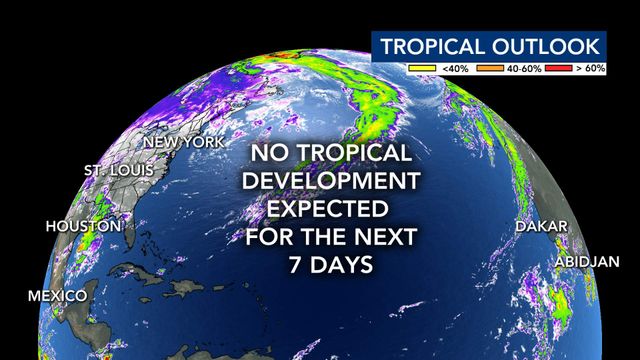Elsa Strengthens Into a Hurricane Ahead of Landfall in Florida
After whipping Cuba with heavy rains and strong winds, Tropical Storm Elsa passed near the Florida Keys on Tuesday, and then strengthened into a hurricane again before its expected landfall Wednesday morning along the Florida Gulf Coast.
Posted — UpdatedAfter whipping Cuba with heavy rains and strong winds, Tropical Storm Elsa passed near the Florida Keys on Tuesday, and then strengthened into a hurricane again before its expected landfall Wednesday morning along the Florida Gulf Coast.
It has the potential to dump up to 9 inches of rain in some parts of the state before traveling north and bringing stormy conditions to Georgia and the Carolinas.
Elsa would be the first major storm of this year’s Atlantic hurricane season to hit Florida’s mainland. It became a Category 1 hurricane on Friday before weakening over the weekend, and then strengthened into a Category 1 hurricane again Tuesday night.
The hurricane was being watched closely in the Miami area, where rescue crews at the site of the collapsed condominium building in Surfside were forced to temporarily pause their efforts Monday because of lightning. Officials said they hoped that the brunt of the storm would spare Surfside, and on Tuesday afternoon, Elsa’s center appeared to be passing more than 100 miles west of Miami.
As of 11 p.m. Eastern time Tuesday, the storm was about 65 miles southwest of Tampa, Florida, with maximum sustained winds of 75 mph, the National Hurricane Center said.
It was moving north at 14 mph, the center said, adding that after making landfall in the northern part of Florida, Elsa will then weaken as it moves northeastward across the southeastern United States through Thursday.
A hurricane warning was issued for west-central Florida and north toward the Florida Panhandle. A tropical storm watch was also issued for the Georgia coast and parts of South Carolina.
“Preparations to protect life and property should be rushed to completion,” the hurricane center said of those under a hurricane warning.
Up to 9 inches of rain could fall through Wednesday in the Florida Keys and the southwestern and western parts of the state, possibly leading to flooding. Elsewhere across Florida, as much as 6 inches of rain could fall through Wednesday night.
Before the storm, Tampa International Airport said it would suspend operations by 10 p.m. The airport planned to reopen at 10 a.m. Wednesday, after assessing any potential storm damage.
As the storm moves north, parts of southeast Georgia and South Carolina could receive several inches of rain this week, with possible flooding. Ahead of the hurricane, Gov. Brian Kemp of Georgia issued a state of emergency Tuesday night. Gov. Ron DeSantis of Florida also issued a state of emergency Tuesday for several counties.
Tornadoes were a possibility across Florida on Tuesday and Wednesday, but forecasts showed the site of the condominium collapse in Surfside avoiding the worst impacts of the storm.
Elsa cut through Cuba on Monday, bringing gusty winds and torrential rains and felling trees and electricity cables in some cities.
Elsa weakened as it moved across the island Monday, passing about 20 miles east of Havana. The capital was mostly calm Tuesday.
A tropical storm warning for parts of Cuba was lifted Tuesday morning, but heavy rain and flash floods were expected through the day.
While none of Cuba’s rural provinces reported fatalities or significant material damage, Elsa has been blamed for the deaths of at least three people elsewhere in the Caribbean.
The Caribbean Disaster Emergency Management Agency reported one death on Saturday in Soufrière, St. Lucia. And in the Dominican Republic, a 15-year-old and a 75-year-old woman died in separate incidents Saturday when walls collapsed on them in heavy rain, the country’s Emergency Operations Center said in a statement.
Elsa, the fifth named storm of the 2021 Atlantic hurricane season, formed as a tropical storm Thursday. It was upgraded to a Category 1 hurricane Friday, then downgraded to a tropical storm Saturday. Ana became the first named storm of the season, on May 23, making this year the seventh in a row that a named storm developed in the Atlantic before the official start of the season on June 1.
The links between hurricanes and climate change are becoming more apparent. A warming planet can expect to experience stronger hurricanes over time, and a higher incidence of the most powerful storms — though the overall number of storms may drop, because factors like stronger wind shear might keep weaker storms from forming.
Scientists with the National Oceanic and Atmospheric Administration forecast that there would be 13-20 named storms this year, 6-10 of which would be hurricanes, and 3-5 major hurricanes of Category 3 or higher in the Atlantic.
Last year, there were 30 named storms, including six major hurricanes, causing meteorologists to exhaust the alphabet for the second time and move to using Greek letters.
Related Topics
Copyright 2024 New York Times News Service. All rights reserved.






